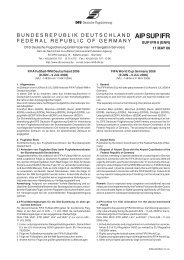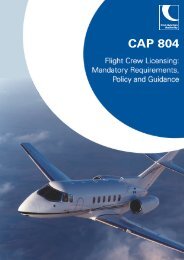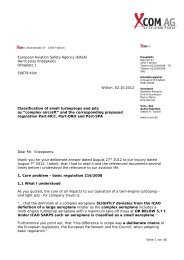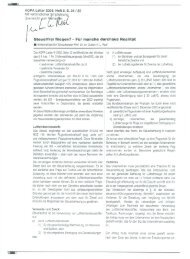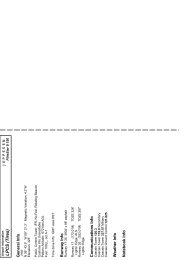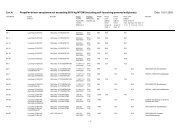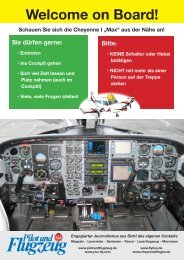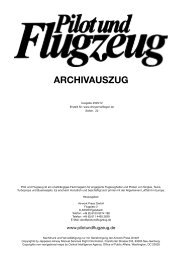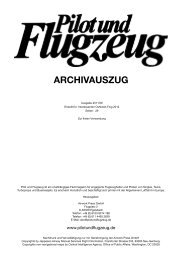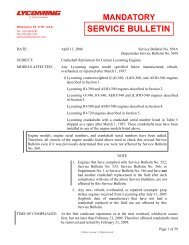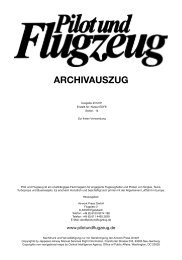The International Comanche Society - Pilot und Flugzeug
The International Comanche Society - Pilot und Flugzeug
The International Comanche Society - Pilot und Flugzeug
You also want an ePaper? Increase the reach of your titles
YUMPU automatically turns print PDFs into web optimized ePapers that Google loves.
haven’t worked their way up the fleet from trainer to fixedgear,<br />
four-seater to complex aircraft, often in many little<br />
steps over many years. Rather they have come to aviation<br />
in mid-life, and have a strong utility view of it. <strong>The</strong>y buy new,<br />
and they buy “the best” straight up. <strong>The</strong> top models sell<br />
better than the base models.<br />
And so the product is being tailored to this market. Features,<br />
fitout and finesse all rate highly. You simply can’t sell a cell<br />
phone without countless features, even though most are not<br />
used downstream by the customer. But it’s the packaging<br />
and inclusion of features that sells, not the basic call function.<br />
Likewise, this market is buying airplanes that look and<br />
feel like cell phones or PCs – for them it’s a familiar environment.<br />
You can even get an airplane with a remote to control it!<br />
This is very important to us. It means that the future of<br />
our aircraft has to come from it having a desirability of its<br />
own – it will not have the sleek finish of the new plastic airframes,<br />
and few will be fitted out with an integrated and<br />
ergonomic glass flight environment.<br />
So our <strong>Comanche</strong>s have to be classy – seen as the “real deal;”<br />
aircraft flown and desired by aviators. <strong>The</strong>y also have to be<br />
affordable to operate and capable of <strong>und</strong>ertaking a wide range<br />
of missions – from the local scenic flights to flexible and<br />
efficient cross-country hauls in a range of IFR conditions.<br />
This then is one of the key responsibilities of ICS, and by<br />
the way the reason that any <strong>Comanche</strong> owner who is not a<br />
member just isn’t doing themselves a favour.<br />
Secondly, our aircraft may be quite confronting to a generation<br />
brought up in the current crop of certified aircraft just because<br />
of their <strong>und</strong>erlying complexity of operation. <strong>The</strong> Twinstar made<br />
an impression on me. <strong>The</strong> engines basically had simple controls<br />
– Fuel on/off/xfeed, one engine on/off switch, one engine test<br />
switch, one power lever … and a key starter. That’s about it.<br />
All the rest is hidden and safely managed by the aircraft.<br />
Compare that to our twins. To keep the engines happy, you<br />
need to correctly manage the following controls – throttle,<br />
propeller, mixture, cowl flap, alternate air, electric fuel pump,<br />
magnetos, mechanical fuel selector, tip tank electrical solenoid<br />
… and the starter. So there are over 20 items in the<br />
cockpit which have to be set, <strong>und</strong>erstood and managed for<br />
correct engine operation. And I have not included the numerous<br />
gauges to monitor - RPM, MAP, EGT, CHT, FF, fuel quantity,<br />
oil pressure and oil temperature. Perhaps, I should have<br />
said “almost 40 items” to manage and <strong>und</strong>erstand.<br />
Now we are all comfortable with that level of complexity,<br />
and for many, mastering that is part of the appeal. But I<br />
can’t help thinking that this may be a barrier for the current<br />
crop of buyers. In fact, will they see a <strong>Comanche</strong> as an<br />
upgrade or not?<br />
To create this long term value, we need to make and reinforce<br />
our aircraft as an “aspiration” possession – having their own<br />
mystique, own appeal, and drawing looks and comments on<br />
the ramp. Old beaters just won’t do it – they will be perceived<br />
as complex and unsafe.<br />
So we all have responsibilities in this – the ICS and its<br />
members.<br />
<strong>The</strong> ICS team is going to work on the big issues – the FAA<br />
and continuing airworthiness, the Flyer, the technical support<br />
to members and ensuring the preservation of the many lifetimes<br />
of accumulated <strong>Comanche</strong> knowledge.<br />
You need to work on the small things – keeping your aircraft<br />
truly airworthy, making sure it has shoulder harnesses, keeping<br />
yourself fit and current, and flying the aircraft actively.<br />
Together there’s a great outlook for many happy years of<br />
personal aviation ahead.<br />
Regards,<br />
Lawrence<br />
<strong>Comanche</strong> Flyer Submission Guidelines<br />
All members are encouraged to submit articles for publication in the <strong>Comanche</strong> Flyer. If you have an article about<br />
a maintenance event, trip, piloting technique, or anything else pertinent to <strong>Comanche</strong> ownership, please share it with<br />
your fellow members.<br />
For those with access to the Internet, please submit the article via e-mail, preferably in Microsoft Word. You may<br />
also include the article in the body of your e-mail message. Include your full name, as you would like it published, and<br />
your ICS number.<br />
Please attach digital pictures, if applicable, in jpeg format. For best results, use the highest resolution setting your<br />
camera will allow. Photo files <strong>und</strong>er 500 kb in size typically do not reproduce well.<br />
Send to:<br />
Kim Blonigen, Managing Editor at kblonigen@cox.net<br />
Articles and photos may also be sent via U.S. Mail to:<br />
Kim Blonigen<br />
2031 South Beech • Wichita, KS 67207<br />
Although submissions are reviewed for technical accuracy, the information in this magazine is meant for reference<br />
only. Any modifications, alterations, or major repairs to U.S. aircraft require FAA-approved data as a basis for beginning<br />
work, and as such should not be based solely on information contained in this magazine. <strong>The</strong> <strong>International</strong><br />
<strong>Comanche</strong> <strong>Society</strong> does not endorse any piloting adverse to published FAA regulations.<br />
Submissions are subject to editing and revision unless specifically requested to be published as submitted. <strong>The</strong> right<br />
is reserved to publish or not, any submission.<br />
Deadline for all submissions is the 20th of the month, approximately 40 days prior to month of publication.<br />
SEPTEMBER 2006 <strong>Comanche</strong> Flyer • 3





